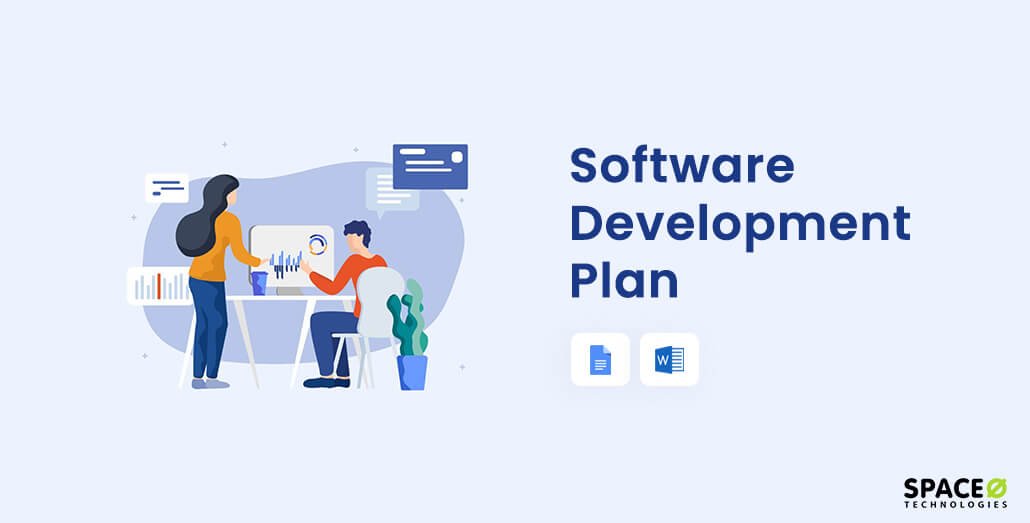If you are looking for a software development project plan, you are in the right place. Throughout this post, we will be highlighting everything from important elements of a software development plan to various stages of SDLC (Software Development Life Cycle). If you’re excited, keep reading.
We know that providing tailored software development services takes a lot of effort. Building custom software product from scratch that delivers value to your business is certainly one of the most intricate processes. However, with the right strategy and a sound software development plan, you can effortlessly turn around projects of any size and scale. To help you handle even the most complex software development projects, we have prepared a comprehensive guide that will touch upon every aspect of the process. But before we get started, let’s first understand what is the software development plan.
Table of Contents
What is a Software Development Plan?
A software development plan describes a strategy for executing software development efforts. It enables all the stakeholders to estimate the total time and resource consumption in a particular software project.
What is the Purpose of a Software Development Plan (SDP)?
We can say that the main goal of software project planning is to streamline the process to ensure the client and user requirements, preventing issues or miscommunication. But, how should the software projects plan be done? Let’s dig deeper into the what should be the purpose of developing software products:
- To keep clear and concise communication with the development team members and the stakeholders during the entire software project plan.
- Track the utilization of the resources by the project managers.
Download FREE Software Development Plan Template
Don’t worry if you are seeking guidance on how to develop a software but don’t know where to start. We have done the heavy lifting for you. With our ready-made software project plan templates (SDLC Template), you will be able to create a roadmap for execution in a matter of minutes.

Download Software Development Plan
Want to get software development plan to start your next project?
3 Important Elements of Software Development Plan
There are a few elements vital for executing a software development plan. They play an important role in the agile software development process. Here, let’s quickly look at 3 factors of a software development plan:
Risk Management
When it comes to software development, there are chances that something may not work as desired. This is where risk management comes into play. You identify the risks, prioritize them, and create a software development plan for mitigation.
Resource Allocation
You will have to carefully allocate adequate resources for different software development phases. Allocating resources adequately will ensure seamless project execution. This means you will have to evaluate total time, work, and resource consumption and allot resources accordingly. Improper resource allocation may result in unusual delays in project delivery and may hamper the timeline.
Documentation
Creating instructions and information to help users interact with the software is extremely important. But that’s not all. You also want to have agreements in place about the software maintenance policy and updates. This will help you set clear expectations and avoid any conflicts pertaining to software maintenance post-development.
Want to Develop a Custom Software Solution?
Our software consultants will tailor a solution to your needs with their experience and expertise.

Advantages of Software Development Life Cycle
The main reason behind implementing SDLC is performing control over the entire development process. It is essential to have a working plan, budget management. Also, the efficient conflict management between participants is also an added advantage. These are some of the big advantages of streamlining the software development processes.
Software development life cycle offers below mentioned advantages.
- Having total command of the software development process
- Increasing the efficiency and efficacy of resource management
- Provides a clear action plan for teams.
- Encourages participants to work together more effectively
- It’s crucial to remember that all of the benefits of the software development life cycle aren’t available to project team members on their own. The cycle will break down if project managers lack knowledge or some participants refuse to follow the procedure, affecting the quality of the final product.
The incompetency of your managers may also result in the failure of the entire SDLC management. Therefore, make sure to create proper software development project plans as well as software project documentation prior to implementing the changes.
6 Stages of the SDLC
There are several stages in the SDLC process. Being a project manager, you have to think about everything, from gathering requirements to development and ongoing support. To make it easier, you can opt for a SDLC project plan template, which gives an overview of each phase of the software development.
Here, we have highlighted seven steps that will remain the same in any software development process. However, the order and sequence of them may change based on your needs, goals, project, and team. For now, let’s look at each one of those steps.
Planning & Analysis
When you receive a customer’s query, the first step is to analyze thoroughly whether you will be able to fulfill their project requirements or not. This usually involves:
- Understanding whether the project aligns with your company’s larger vision and goals
- Ensuring that you have the right tools and resources to meet your client’s expectations
- Accessing your current bandwidth to understand whether you will be able to deliver the project in a prescribed time frame
- Evaluating the total cost and resource allocation associated with the project
The first step in the SDLC is crucial because the stronger you start, the execution will be effortless during the later stages. Thus, involve all the departments and individuals whose involvement is necessary for successful project completion.
Now that you’ve gathered enough information about the project, it’s time to create the scope of work — a detailed plan that exhibits what’s being developed and why.
Requirements
The very next step after understanding the scope of work is to understand the specific requirements of any project. Everything you create — be it software, website, or an add-on — should solve a real problem.
Thus, as you transition from planning to gathering requirements, ask questions that will help you understand which problem the client is trying to address through this software or solution. For instance, you may ask:
- Who will be interacting with the software/app, and why?
- Do you need to make this software work with other applications?
- What customer data will you be handling?
These kinds of questions will help you understand what exactly the client is looking for. They don’t just need software. They need software that helps them monitor their employee’s performance.
Once you know what your client needs, scope out the technical requirements. For instance, what tech stack will work best, which kind of custom features you need to build, and what should be the software’s primary functions. This will also help you determine which resources will be working on that project and until when.
Design & Prototyping
Now that you know what’s required, you can start creating the prototypes of the software. It doesn’t need to be 100% perfect. But it should give the client a feel of what they can expect post-development.
Here, you might need to create interactive wireframes, layouts, or just designs — depending on the software you are building. Through this phase, you will be able to validate ideas and get feedback from your client, their end-users, or the stakeholders.
Software Development
Once you have developed the wireframes, it’s time that you convert them into clickable software. This is the phase where actual coding begins. The developers create software and its functions based on the final wireframes created during the previous step.
This could be the longest phase in a software planning process. While coding, developers must adhere to the best coding practices to avoid any major technical glitches.
Testing
Now when the software is fully developed, the testing process begins. The QA team examines the software to ensure its 100% operational. They check the functionality and the overall workflow to verify if the software performs as intended.
During this phase, the QA team will send bug reports to the developers and re-test them once they are resolved. This to and fro process will continue until all the bugs are resolved, and the software is stable and performs as required.
Deployment
Finally, when the software is fully functional and bug-free, the deployment process starts. Often times, this process is simple. It involves releasing the software so that it’s publicly accessible. However, in some cases, software deployment can be complex. For instance, when you need to upgrade an entire company’s tech stack or their digital infrastructure. In such cases, the deployment may take considerable time.
Maintenance & Updates
The SDLC doesn’t end on deployment. It’s lifecycle — which continues even post-deployment. That’s because software packages are dynamic. They evolve with business needs. Thus, you must be ready to add new features as and when needed.
Furthermore, all software programs need maintenance and optimization periodically. You may need to maintain the software, so it consistently delivers an engaging experience.
How to Plan Software Development
Planning a software project requires a thorough grasp of the project scope and the objective of software development plan.
Meet the Client
Interviewing your client will help you gain clarity over the project and its objective. During the interview, take notes, ask questions, and know as much as possible about the project. Being clear about the project will enable you to execute things more efficiently.
Pick your Players
Once you know what exactly your client is looking for, it’s time to build a team that’d help you execute on the idea. To get the best results, you should hire an experienced software development company.
Identifying the departments involved during different phases and discussing the project with the team will help you identify potential risks or inconsistencies. This way, you will be able to plan and execute software development more efficiently while reaping the advantages of custom-built software.
Discuss the Project & Seek Feedback
Share your client’s vision and expectations with the team and ask them to share their feedback. It will help you identify potential risks or inconsistencies in the project. This way, you will be able to plan and execute software development more efficiently.
Looking to Convert Your Project Idea into Reality?
Tell us your requirements. We have a team of experienced software developers to convert your project idea into a real-time solution.
Have some common questions in mind? Not to worry. Here, we have answered the most common questions that most people have related to the software development plan.
Frequently Asked Questions
What does SDLC stand for?
SDLC stands for Software Development Life Cycle.
What’s the difference between SDLC and STLC?
SDLC (Software Development Life Cycle) defines all the phases involved in the software development process. On the contrary, STLC (Software Testing Life Cycle) deals with the entire quality testing process — and not the development part itself.
How do I create software development life cycle templates?
To make things easier for you, we have attached a free software development planning template above. You can download it from here. Alternatively, you can also create a software development template for yourself by using various project management tools.
Schedule a Free Call For Software Development
Project management certainly has a lot of moving pieces to it. Starting from creating a plan to gathering software requirements and ensuring timely project deliverables, you have to take care of everything. We hope this guide will help you create a software plan based on your requirements.
If you are seeking to get help for custom software development requirements, we will be happy to help. Schedule a free consultation call with our experts today, who will guide your software development all the way through its successful completion.



